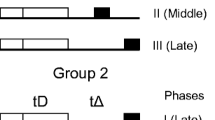Summary
Two experiments were performed to examine the reinforcing effects of onset and termination of non-aversive illumination, made conterminous with lever contacting, as a function of illumination level. Within the 0.18–4.10 millilambert range studied, reinforcing properties of light onset were found to yield a concave-downward function while light termination was not found to alter response rate. Implications of the results for several current theories were discussed and a possible integrating concept, termed “sensory reinforcement” was proposed.
Similar content being viewed by others
References
BARNES, G. W. and KISH, G. B. Reinforcing properties of the termination of intense auditory stimulation. J. comp. physiol. Psychol., 1957, 50, 40–43.
BARNES, G. W. and KISH, G. B. On some properties of visual reinforcement. Amer. Psychologist, 1958, 13, 417 (abstract).
BUTLER, R. A. Discrimination learning by rhesus monkeys to visual-exploration motivation, J. comp. physiol. Psychol., 1953, 46, 95–98.
DOLLARD, J. and MILLER, N. E. Personality and psychotherapy. New York: McGraw-Hill, 1950.
GIRDNER, J. B. An experimental analysis of the behavioral effects of a perceptual consequence unrelated to organic drive states. Unpublished Ph.D. dissertation, Duke University, 1953.
GLANZER, M. Curiosity, exploratory drive, and stimulus satiation. Psychol. Bull., 1958, 55, 302–315.
GUTHRIE, E. R. The psychology of learnng. (Rev. Ed.). New York; Harper, 1952.
HULL, C. L. A behavior system. New Haven: Yale Univ. Press, 1952.
HARLOW, H. F. Motivation as a factor in the acquisition of new responses. In J. S. Brown (Ed.) et al. Current theory and research in motivation. Lincoln: Univ. of Nebraska Press, 1953. pp. 24–49.
KAPLAN, M. The effects of noxious stimulus intensity and duration during intermittent reinforcement of escape behavior. J. comp. physiol. Psychol., 1952, 45, 538–549.
KELLER, F. S. Light aversion in the white rat. Psychol. Rec., 1941, 4, 235–250.
KISH, G. B. Learning when the onset of illumination is used as reinforcing stimulus. J. comp. physiol. Psychol., 1955, 48, 261–264.
MARX, M. H., HENDERSON, R. L., and ROBERTS, C. L. Positive reinforcement of the bar-pressing response by a light stimulus following dark operant pretests with no after effect. J. comp. physiol. Psychol., 1955, 48, 73–76.
MONTGOMERY, K. C. The role of exploratory drive in learning. J. comp. physiol. Psychol., 1954, 47, 60–64.
SPENCE, K. W. Conditioning and behavior theory. New Haven: Yale Univ. Press, 1956.
Author information
Authors and Affiliations
Additional information
A part of this paper is based on a thesis submitted by the third author to the Faculty of Graduate Study, University of Maine. The first two authors, however, assume full responsibility for the present treatment of the data.
The reported studies were supported in part by research grants from the Wilson Coe Research Fund, University of Maine.
Rights and permissions
About this article
Cite this article
Barnes, G.W., Kish, G.B. & Wood, W.O. The effect of light intensity when onset or termination of illumination is used as reinforcing stimulus. Psychol Rec 9, 53–60 (1959). https://doi.org/10.1007/BF03393326
Published:
Issue Date:
DOI: https://doi.org/10.1007/BF03393326




